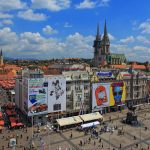The tour is organised every day, and it is “paid” with charity contributions.
“If someone finds an abandoned dog in the city, within 24 hours the dog will get a roof over its head and food, and maybe even a new family. But what about people living on the streets?” says Mile Mrvalj, the founder of the Fajter association, which helps homeless people in Zagreb, reports Večernji List on August 25, 2018.
In order to focus people about the growing problem of homelessness in the city, and to show to all those interested a parallel world which we are all passing by next to every day, the Fajter association, based on the idea by Branimir Radaković from the Brodoto agency for socially responsible projects and marketing, has launched tours of the city which they called “Invisible Zagreb”.
“Since ID cards are linked to properties, homeless people in Croatia does not have them. Without the card, we do not exist in the administration system. We do not even exist for the citizens because no one wonders where the man they saw today collecting bottles will sleep in the evening. We are invisible and with this tour, we have decided to show who the homeless people are and why we should all be more concerned about them,” says Mile, who knows how it is to live on the streets.
The tour which he leads is held five times a week and lasts for one and a half hour. The participants learn various info about homeless people, from devastating statistics to painful facts of life they are facing. The walk through the town was initially conceived as an awareness-raising tool but, in co-operation with the tourist board, it has also become a somewhat of a tourist programme, so there are foreign tourists who take part in it. However, project manager Branimir Radaković says that about 80 percent are Croatians.
The first checkpoint is next to the statue of King Tomislav in front of the main train station. “Look at all these people enjoying themselves,” says Mile, pointing towards people lying on the grass. “Homeless people are not allowed to do that because of the misdemeanour law which states that vagrancy is fined with up to 2,000 kuna or 15 days of prison. Homeless people have to hide in smaller parks where they cannot stay long because of the fear of the police. There are about 2,000 such people in the city.”
“It’s all good during the summer. When the winter comes, the everyday hell begins,” says Mrvalj, adding that homeless people sleep on the glass and on garbage at temperatures of -20 degrees, and in the morning they have just one wish – to rush to a coffee machine at the main train station. Not because they cannot start their day without coffee, but because of the cold. “We lean on the machine to warm ourselves, but we cannot stay longer than half an hour because the police would come. After that, we either collect bottles or make a few rounds in a tram in order to get warm,” says Mile at the second checkpoint, at the main station.
The last point of this emotional tour of Zagreb is the adrenaline park behind the station because the park is the substitute for the Tomislav Square where homeless people are not allowed to stay.
If you are interested to see how the homeless people are spending their days, you can join the tour daily. It is free, but voluntary contributions are expected.
Translated from Večernji List (reported by Jelena Ružić).









